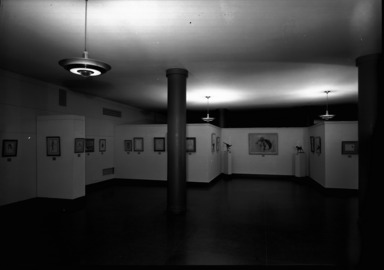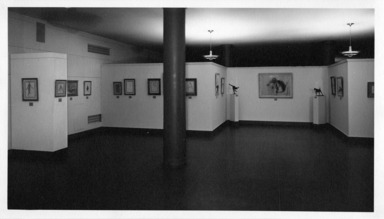
French Drawings from the Collection of Paul Sachs
DATES February 19, 1939 through March 12, 1939
ORGANIZING DEPARTMENT
European Painting and Sculpture
COLLECTIONS
European Art
-
February 11, 1939
On Wednesday, February 15, the Brooklyn Museum will open an exhibition of drawings from the collection of Professor Paul Sachs. The exhibition will run through March 12. The artists represented are: Chasseriau, Portrait of Mme. Mottez; Corot, two drawings; Daumier, Two lawyers conversing; Degas, twelve drawings; Delacroix, three drawings; Gauguin, Head of a girl; Gericault, two drawings; van Gogh, Wounded veteran; Guys, Amazon; Ingres, six drawings; Jacque, Children feeding chickens; Manet, Interior of a cafe; Meissonier, two drawings; Millet, Offering to Pan; Rodin, Nijinskiy; Rousseau, Landscape; Rops, Bust of a woman; Matisse, two drawings; Picasso, six drawings; Valadon, Nude girl on a couch; Prud’hon, Nymph and Cupids.
Brooklyn Museum Archives. Records of the Department of Public Information. Press releases, 1939. 01-03/1939, 028.
View Original -
February 3, 1939
On Friday, February 3, the Brooklyn Museam will open an exhibition of drawings from the collection of Professor Paul Sachs. The exhibition will run through March 5. The artists represented are: Chasseriau, Portrait of Mine. Mottez; Corot, two drawings; Daumier, Two lawyers conversing; Degas, twelve drawings; Delacroix, three drawings; Gaugin, Head of a girl; Gericault, two drawings; van Gogh, Wounded veteran; Guys, Amazon; Ingres, six drawings; Jacque, Children feeding chickens; Manet, Interior of a cafe; Meissonier, two drawings; Millet, Offering to Pan; Rodin, Nijinsky; Rousseau, Landscape; Rops, Bust of a woman; Matisse, two drawings; Picasso, six drawings; Valadon, Nude girl on a couch; Prud'hon, Nymph and Cupids.
Brooklyn Museum Archives. Records of the Department of Public Information. Press releases, 1939. 01-03/1939, 046.
View Original -
February 19, 1939
Fifty drawings lent from the celebrated collection of Dr. Paul J. Sachs of Cambridge, Massachusetts, have been placed on exhibition at the Brooklyn Museum and will be on view there through March 12th.
Drawing in art has been more or less out of fashion for some time, but there are signs that it is coning back into vogue. The fifty French drawings from the collection of Professor Sachs are therefore pertinent reminders that such various artists as Picasso, Gauguin, Matisse, Degas and van Gogh at one end of the swing of the pendulum and Ingres, Meissonier and Prud'hon at the other knew how to draw, did draw and were not above making very careful studios in drawings for their painted masterpieces, no matter how great the apparent freshness and freedom in the finished work.
It is a far cry from the extremely detailed and careful pencil studios of Ingres for his portraits of Mme. Hayard and Mme. d'Haussonville to the studios of Degas for the racy and not at all pretty portrait of Diego Martelli, a stolid and stocky person seated at his not very easy ease in shirtsleeves with defiantly folded arms. Again Prud’hon does a Naiad in the midst of a mild rough-house perpetrated by little Cupids with almost the finish of an exhibition piece instead of a preliminary study, and Delacroix makes of a lion hunt an abstract whirl of decorative lines that expressed the action of the composition rather than any precise detail of form.
Where there is a range of work, as by Ingres, Degas, and Picasso, one has the opportunity of studying the artist in various moods, drawing in various ways and for various purposes.
The exhibition is one that will appeal to connoisseurs and students especially, but there is also plenty of subject matter and decorative variety to please the casual gallery visitor who just likes to look at good things, a very pardonable whim.
The taste of the man in the street has always erred in favor of draftsmanship as represented by photographic realism and slick finish. That educated taste In art should have veered so far away that draftsmanship became a matter of reproach is one of those curious phenomena of art history that probably had a variety of causes. One was the discovery within the arts, coincident in time at least with the development of psychology as a science, that there was something pleasant in the effect of a line that was recorded by free movement of the artist's moving hand and something unpleasant in a line that perpetually checked that movement for the sake of accurate and precise representation. We came to think of a beautiful line as one quickly and freely drawn with a large rhythm of creative movement and came to scorn the carefully controlled line that departed from accuracy just enough to be "beautiful" whatever that was.
But again coincident was the vogue of the sketch and the anathema against finish, which resulted in rich traffic in the unfinished sketches of artists and much production of painting that looked sketchy. Probably the responsibility for this vogue must be divided over many shoulders. It is a nice turning of the tables to have a collection of sketches make the point that our sacred masters from the most classic to the most romantic and rebellious were not so free and sketchy in their sketches as we have been led to assume.
Brooklyn Museum Archives. Records of the Department of Public Information. Press releases, 1939. 01-03/1939, 060-1.
View Original
